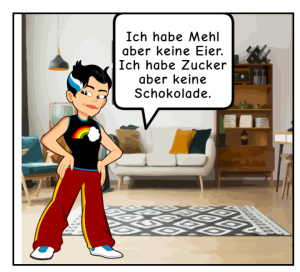6.11 Eine Einkaufsliste schreiben

Guten Tag!
Zum Aufwärmen machen wir unseren Tagesminiplausch und eine Wiederholung.
Wiederholung
In the previous lesson, you learned about the diversity of foods in Germany, how to express that you are hungry and/or thirsty, and how to say want you want to eat. Let’s review what you have learned.
For a moment inhabit your German child persona. You feel hungry and thirsty. How would you express that? Now (like a demanding child 🙂) say what you want to eat. Write these sentences in your written journal. Then practice reading them aloud in your audio journal.
Lektionsüberblick
Do you enjoy cooking or baking? If so, you will enjoy knowing how to use a recipe in German. But even if creating in the kitchen is not your zone of genius, you will benefit from understanding the metric system, which is used everywhere but in the U.S. In the end, you will be able to 1) use metric weights and measurements, 2) read a recipe, and 3) write a shopping list based on recipes.
Was weißt du schon?
Let’s do a quick skills check.
| Noch nicht start klar?
Du kannst immer auf die gleiche 1010-Lektion zurückgreifen! |
Not confident about starting this lesson?
You can always review the same Lektion from 1010. |
1) Weights and measurements
When reading a recipe in German, you will notice right away that the measurements are different than in English. Take a look at the cake recipe below that Sofia plans to bake for Teestunde this week. Pay close attention to the measured ingredients (Zutaten). What words do you recognize? What notations are new to you? Try completing the activity beneath the recipe using your prior knowledge of food names. If you find it too tricky, read the Kleiner Hinweis below and try again.
Französische SchokotarteZutaten:
|

|
For a deep dive into converting German recipes into English measurements, you can read this helpful article.
Jetzt bist du dran!
2) ein Rezept lesen (reading a recipe)
Now it’s your turn to choose a recipe. You can take a look at these Recipes in German. Choose one that looks lecker to you. Now consider the following questions:
- What words do you recognize?
- What measurements do you recognize?
- What ingredients do you already have?
- What ingredients will you need to buy?
Sofia has looked closely at the recipe above for Französische Schokotarte. Here is what she has noted about the ingredients she has and the ingredients she doesn’t have. Read and listen.
 |
Let’s practice.
Kochst du gern? Do you like to cook? If so, you can find a whole glossary of cooking words here.
Jetzt bist du dran!
3) die Einkaufsliste schreiben (writing your shopping list)
Now let’s build your shopping list for the recipe you have chosen. Depending on your recipe, you might need ingredients from the following categories: Obst, Gemüse, Fleisch/Fisch, Milchprodukte, anderes…
Here is what Sofia will need for her recipe to give you an idea (She also needs some tea for her Teestunde):
EinkauflisteMilchprodukte Butter
Anderes Schokolade Eier Tee
|
Jetzt bist du dran!
Zum Schluß

*As you conclude this lesson, don’t forget to check Canvas!*

Media Attributions
- 1020-banner-large-reduced
- Photo of chocolate torte by pexels-delphine-hourlay-91322-691152
- Comic made at www.MakeBeliefsComix.com

